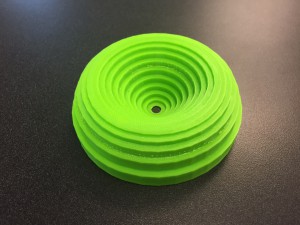To get my solid, I rotated the area between the curves \(y=x\) and \(y=x^2\) around the line \(y=1.25\). I then approximated it by cylindrical shells. The width of each of my shells was 1/16 and the height was \(x^2-x\), where the \(x\)-value was chosen from the right endpoint of each interval.
One of the issues with the print comes from the fact aht the top shell does not connect smoothly to the shell below it. Initially I thought that this resulted from an error in the printer. When I looked at the Cinema 4D file, however, I discovered that the top shell does not make contact with the shell below it because its height is less than 1/16 (the bowl shape is very flat there). Additionally, the shell second from the top does not make contact with the shell below it, but the height difference is not noticable. Another issue with the print was that the leftover supports look bad. The inside of the object was filled with them, and even after clearing out most of the supports, it still looks terrible. We are thinking about printing the object on a different printer, such as the Form Labs printer (which uses stereolithography) or the ProJet 260 (which uses powder), in order to get the inside part of the object to look clean.





